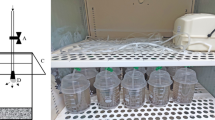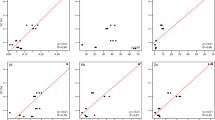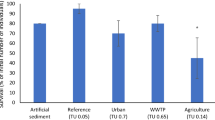Abstract
Background, Aims and Scope
Single-species toxicity tests are currently used as main tools for assessing effects in ecological risk assessments. Nevertheless, in higher-tier evaluations, alternative ecotoxicological methods can be required. Alternative methods should cover more realistic exposure conditions and/or additional species or endpoints. Water/sediment systems can be considered for covering additional exposure routes. A typical feature of water/sediment systems is the modification of exposure levels with time. The simultaneous exposure of different species within the same system can cover differences in sensitivity and relevance of exposure routes. The aim of this study was to develop a water/sediment test that could detect relevant effects on two selected species and explore the relevance of sediment and waterborne exposure routes. This alternative method may provide relevant information facilitating the design of microcosm and mesocosm studies.
Methods
A multi-species water/sediment system was designed using two invertebrates: Chironomus prasinus a benthic detritivore invertebrate and Daphnia magna a pelagic filtering invertebrate was designed. Seven static water/sediments systems were built up: two controls and five treatments where sediments were spiked with NaPCP at nominal concentrations of 1.25, 2.5, 5, 10 and 20 mg/kg, respectively. Each system contained caged and free (unrestrained) Daphnia magna organisms to consider differences in the exposure route (through sediment and/or water column) and Chironomus prasinus organisms. Fate and partitioning of PCP within the water/sediment compartments were assessed. Acute (lethality) and chronic effects (reproduction) for Daphnia magna were monitored after 48 h and 16 days of exposure, respectively. Adult emergence and oviposition success of Chironomus prasinus were monitored at the end of test (16 days).
Results and Discussion
Mortality and reproduction inhibition of Daphnia magna occurred at the two higher doses, corresponding to maximum measured PCP water concentrations of 1.95 and 0.746 mg/l, respectively. Chironomus prasinus was less sensitive to PCP than Daphnia magna. Concentrations inhibiting reproduction and provoking almost 100% adult mortality in D. magna only reduced slightly the emergence and reproduction of chironomids. The experimental design focussed on suitability of the system for assessing simultaneously assessing effects on D. magna and C. prasinus instead of calculations of toxicity endpoints for PCP. The results indicate that this experimental design can be useful to the field of sediment/aquatic toxicity testing, particularly through the comparison with single- species results. Assessment of relative contribution of two exposure routes for Daphnia magna and complementary chronic endpoints derived from two different species can be achieved. Another advantage is that differences in reproduction strategies of selected species (sexual vs. parthenogenetic) should permit one to detect mechanisms of action associated to with endocrine disrupters.
Conclusion
The feasibility of a two-species test built-up in an artificial sediment/water system has been demonstrated. This experimental design represents a cost/effective test which can assess effects through water and sediment pathways and incorporates several relevant chronic endpoints in a single assay.
Recommendation and Outlook
By building on the experience gained, improvements for further test designs are discussed. Test validation with a set of model chemicals will contribute to address the effectiveness of the test developed as comparing compared to single- species tests.
Similar content being viewed by others
Author information
Authors and Affiliations
Corresponding author
Rights and permissions
About this article
Cite this article
Sánchez, P., Alonso, C., Fernández, C. et al. Evaluation of a Multi-species Test System for Assessing Acute and Chronic Toxicity of Sediments and Water to Aquatic Invertebrates: Effects of Pentachlorophenol on Daphnia magna and Chironomus prasinus (6 pp). J Soils Sediments 5, 53–58 (2005). https://doi.org/10.1065/jss2004.10.114
Received:
Accepted:
Published:
Issue Date:
DOI: https://doi.org/10.1065/jss2004.10.114




